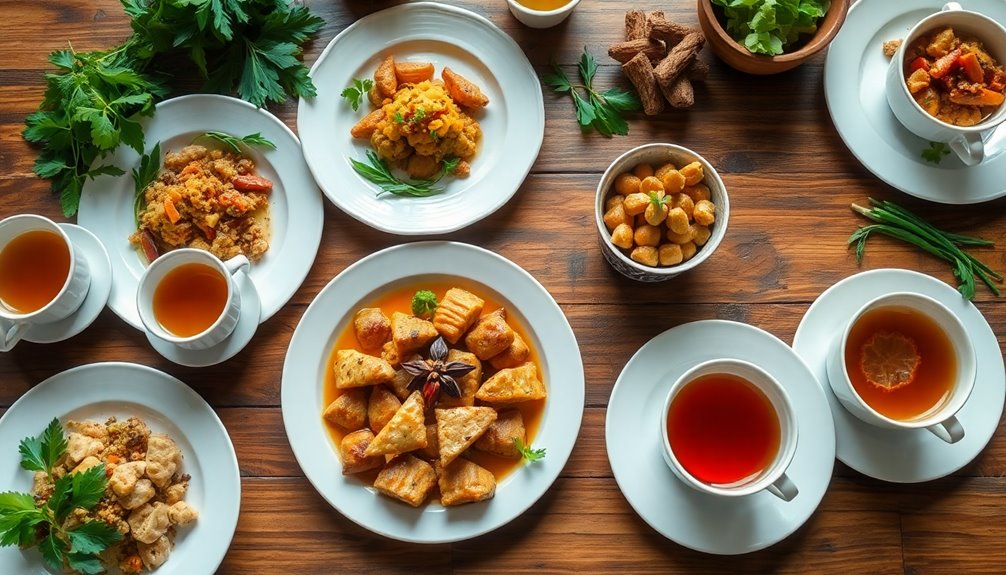To enhance your spicy meals, pair them with teas that cool the palate and balance heat. Herbal teas like chamomile and hibiscus offer natural sweetness to counteract spiciness. Green tea refreshes your mouth while aiding digestion, and chai with milk helps neutralize capsaicin's burn. Iced teas with fruity notes can provide a cooling sensation, too. Don't forget about mint tea, favored for its soothing properties. These combinations not only elevate the flavors but also improve your overall dining experience. There's a lot more to discover about perfect tea pairings that can complement your favorite spicy dishes.
Key Takeaways
- Herbal teas like chamomile and hibiscus provide natural sweetness that counteracts the heat of spicy foods.
- Green tea's light acidity refreshes the palate and complements complex flavors in spicy dishes.
- Chai tea, with its rich spices, elevates the dining experience while balancing the heat from spices.
- Iced teas with fruity or floral bases offer a cooling effect that helps alleviate the intensity of spice.
- Dairy-based teas, such as chai with milk, can bind to capsaicin, reducing the heat sensation effectively.
Introduction
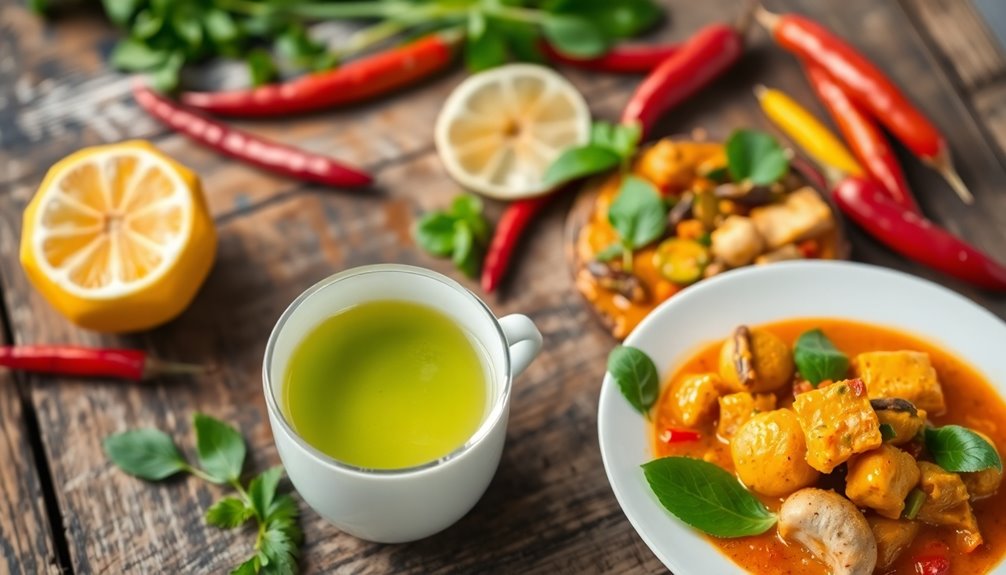
When you dive into the world of spicy foods, you often encounter that fiery kick from capsaicin that can leave your taste buds tingling. To truly enjoy your meal, finding the right tea pairing can help balance that heat and enhance the overall flavors. A refreshing tea can cleanse the palate and provide a delicious contrast to the spiciness.
Sweet teas, like those infused with fruit or honey, work wonders in counteracting the burn, allowing you to appreciate the dish without being overwhelmed. Green tea, with its subtle sweetness, offers a light touch that complements spicy dishes beautifully. Additionally, certain teas, like peppermint oil, can offer a refreshing relief that enhances the overall dining experience. Studies have shown that certain teas can also help reduce inflammation, making them a soothing choice alongside spicy meals. Drinking teas like chamomile can also provide anti-inflammatory properties that may ease any discomfort from the spice. Furthermore, embracing mindfulness techniques while enjoying your meal can heighten the overall experience.
Herbal teas, such as chamomile or hibiscus, can also be excellent choices, as their natural sweetness and refreshing qualities create a delightful pairing. If you're looking for something bolder, chai tea's rich spices can elevate the experience, while still providing a balance. Additionally, many herbal teas contain antioxidants that help combat oxidative stress, making them a healthy accompaniment to your meal.
The key is to choose teas that enhance the flavors of your spicy meal, making every bite enjoyable. So, next time you indulge in spicy foods, consider these tea pairings to create a harmonious dining experience that keeps the fire at bay!
Spicy Food Flavor Profiles
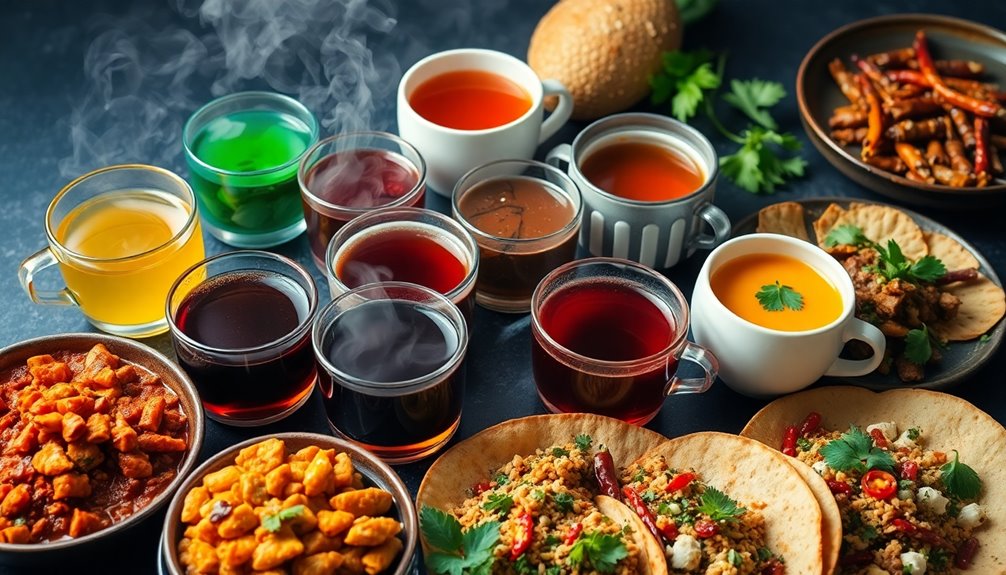
Spicy food flavor profiles are as diverse as the cuisines that create them, featuring a range of heat levels and aromatic spices. From the fiery kick of chili peppers to the fragrant complexity of curry, these dishes present unique challenges and opportunities for pairing.
When you enjoy spicy foods, it's vital to consider how different beverages can enhance or balance those intense flavors. Tea can pair well with these vibrant profiles when chosen wisely. For instance, herbal teas often bring a natural sweetness that effectively counteracts the heat, while green teas, with their light acidity, can refresh the palate and complement the dish's complexity. The right tea can accentuate the aromatic spices, making each bite more enjoyable. Additionally, incorporating ingredients like chia seeds can provide a nutritional boost to your meal, enhancing your overall dining experience. Moreover, choosing beverages that are energy-efficient can align with an eco-friendly lifestyle while enjoying your meal. Chia seeds are particularly beneficial due to their high fiber content, which aids in digestion and promotes regularity. Additionally, some teas, such as green tea, contain antioxidants that may further support your health while enjoying spicy dishes. Drinking celery juice may also aid in hydration, which can be beneficial when consuming spicy foods.
A beverage with a hint of acidity or citrus can elevate the experience, cutting through the heat and adding a refreshing element. If you prefer a sweeter drink, consider options that harmonize with spicy foods.
Whether you opt for herbal or green teas, finding that perfect pairing allows you to enjoy the multifaceted flavor profiles of spicy dishes without being overwhelmed by the heat.
Tea's Cooling Effect on Spice

Choosing the right tea can significantly enhance your experience with spicy foods, particularly when it comes to balancing the heat. One of the most effective options is dairy-based teas, like chai made with milk, which can neutralize the heat from spicy dishes by binding to capsaicin, the compound responsible for that fiery sensation. Additionally, turmeric tea is known for its anti-inflammatory properties, which may help soothe any irritation caused by spicy ingredients. The addition of black tea as a base in chai also contributes to its robust flavor profile, making it a satisfying choice. Oolong tea, with its unique flavor profile, also serves as an excellent pairing for spicy dishes, offering a complex taste that can complement the heat. Moreover, flossing habits established early can lead to better overall dental health, which is beneficial after indulging in spicy foods that may affect oral well-being.
Herbal teas, especially peppermint and chamomile, provide a soothing effect, offering a refreshing contrast after you indulge in heat-packed cuisine. Chamomile tea may also promote relaxation and improve sleep quality, making it a great choice after a spicy meal.
Iced teas with fruity or floral bases can also deliver a cooling effect, making them perfect for counteracting the intensity of spice in your meal.
If you prefer a touch of sweetness, sweetened teas can work wonders in enhancing the overall food experience. The sweetness counteracts the heat, harmonizing flavors beautifully.
Additionally, certain teas contain moderate caffeine, which may stimulate your digestive system and help alleviate discomfort from spicy foods. Furthermore, incorporating herbal teas into your routine can also support your overall health by reducing allergens and improving respiratory well-being.
Cultural Tea Pairing Traditions
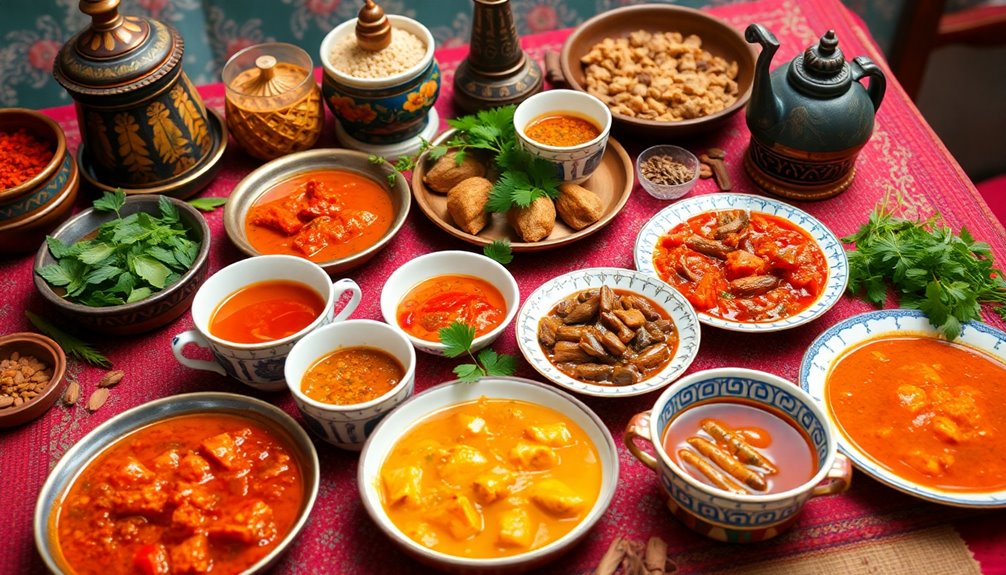
Many cultures have their own unique traditions for pairing tea with spicy foods, enhancing the dining experience and helping to balance intense flavors.
In Asian cuisine, particularly in Thailand and India, tea is often served alongside spicy dishes to cool the palate and elevate the overall flavor experience. Chinese cuisine frequently pairs spicy foods with green tea or oolong, known for their digestive aid properties, refreshing your palate post-meal. This is similar to how aura colors can reflect emotional states and enhance personal experiences. Additionally, the use of chia seeds in traditional dishes highlights the importance of balancing flavors in various culinary practices. Aromatherapy techniques can also play a role in enhancing the overall dining experience by creating a calming atmosphere.
In Mexico, you'll find herbal teas like hibiscus or chamomile complementing spicy dishes. These options provide a cooling effect that contrasts with the heat, making each bite more enjoyable.
Meanwhile, in Middle Eastern cultures, mint tea stands out as a favorite pairing. The cooling properties of mint help balance the heat while enhancing the flavors of the food.
There's a common belief that certain teas can neutralize spiciness. Sweetened or creamy teas are often recommended alongside spicy fare for this reason. Additionally, the health effects of tea consumption suggest that moderation is key to optimizing the benefits of these pairings.
Whether you choose white tea for its subtlety or herbal teas for their cooling effects, these cultural traditions offer valuable insights into how to enjoy spicy foods more fully.
Balancing Heat and Flavor
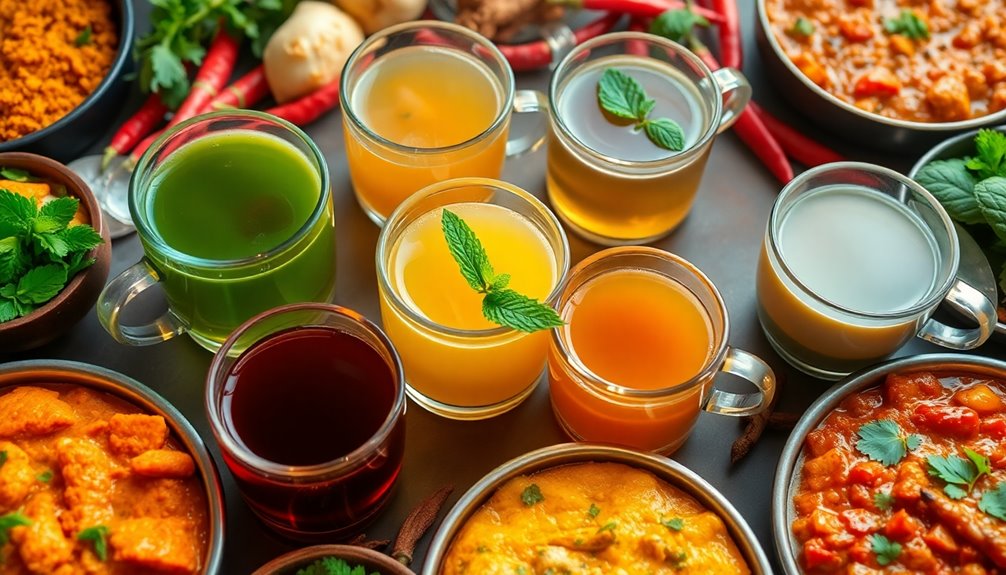
How can you enjoy spicy foods without overwhelming your taste buds? The key lies in balancing heat and flavor. When you pair spicy food with beverages that offer refreshing contrasts, you can elevate your dining experience.
Consider sweet white wines like Riesling; their sweetness can counteract the heat effectively, providing delightful pairing suggestions. Additionally, the emotional well-being of individuals may be enhanced through enjoyable dining experiences that incorporate comforting flavors. This can be further supported by understanding the importance of cookie categories and how they can influence the overall experience. Furthermore, certain fruit juice varieties can serve as an excellent way to complement spicy dishes. Herbal teas, such as chamomile or hibiscus, are also a great option as they are known for their calming effects that can soothe the palate against spiciness.
Experimenting with various tea types, like lighter green teas, can also yield unique pairings that refresh your palate and balance flavors beautifully.
Don't forget about the role of sweetness. Drinks with a hint of sweetness, like fruit juices, can help to cut through the spicy burn, making your meal more enjoyable.
In addition, think about how carbonation in cold beers, especially IPAs, can cleanse your palate between bites, allowing you to savor each flavor without being overwhelmed. Incorporating ingredients like chia seeds in your meals can also provide additional health benefits, enhancing your overall dining experience.
Practical Applications
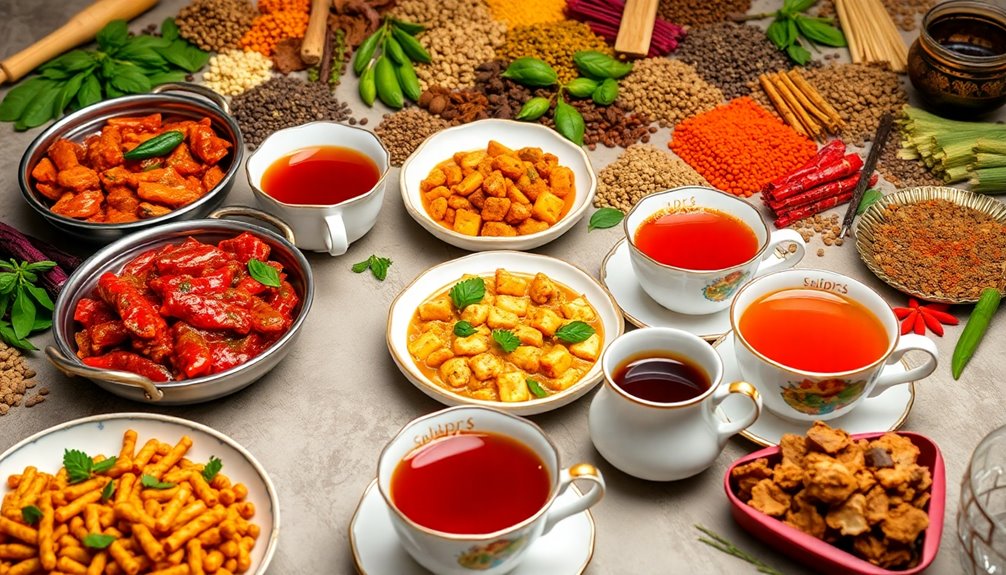
When enjoying spicy foods, practical applications can make a significant difference in your overall experience. Pairing your favorite spicy dishes with the right beverages is crucial. Herbal teas, for instance, often provide a soothing effect that offers palate relief, making them one of the best paired options. Essential oils like lavender can also enhance relaxation when consumed in tea blends. Additionally, herbal teas are generally caffeine-free, which can further promote relaxation. Using essential oils in tea blends can enhance not only flavor but also the calming effects. Studies have shown that caffeine may boost endurance and performance during exercise, making it a beneficial factor to consider when choosing your beverage.
Consider a calming chamomile or a refreshing mint tea to create a perfect match against the heat.
You might also enjoy experimenting with cold drinks. Acidic beverages, like citrus juices, can cut through the spice, providing a refreshing contrast that balances flavors beautifully, especially with spicy tacos or Thai salads.
Sweet drinks, such as fruit juices, can counterbalance the heat effectively, enhancing your dining experience.
Don't forget about dairy-based options! Beverages like lassi or milk can soothe the burn from spicy foods due to their casein content. Additionally, incorporating glycolic acid into your skincare routine can help manage any irritation caused by spicy food consumption.
Lastly, if you're looking for something different, consider sweet wines or even cold IPAs. Their carbonation and refreshing qualities can cleanse your palate between bites, allowing you to savor every flavor.
With these practical applications, you're sure to elevate your enjoyment of spicy foods!
Conclusion
In conclusion, pairing tea with spicy foods enhances your dining experience. By choosing teas that cool and complement the heat, you can elevate both flavors. Whether you're sipping a refreshing mint tea or a soothing chamomile, you'll find the perfect balance to enjoy your meal. Don't hesitate to explore different tea traditions from around the world, and remember, the right tea can transform a fiery dish into a harmonious feast for your taste buds.





